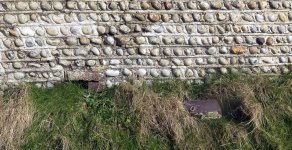Spot the Lizard
Stopping down to a higher f. stop, decreasing the aperture is the easiest and most logical move. And quickest too. NB: bridge cameras will have a lesser range of aperture, but because of a small sensor it will make a greater depth of focus so bridge cameras are much easier. The dial changes aperture on the A setting (and P and S) and this is quick to do and everything can be seen in the viewfinder.
On the Nikon D3200 series and entry level cameras in general the way of changing he focus mode is menu driven (takes longer) rather than button driven. This makes quick focus mode changes slower. This and lots of other things the camera reviews do not tell you!

First thing to do is to spot the lizard in the first place. How many can you see? Then they scarper. Changes need to be made to the settings in four seconds for slow lizards, and eight seconds for sun bathing lizards. Mostly, less than a second. Pre-set settings first. I think I will try out single spot focusing?
My bridge camera can store settings for quick retrieval. My Nikon D3200 can't. It didn't say that in the review either. Within a few days of buying an entry level DSLR camera I came across five quite significant problems.
Sounds like you need to get used to the settings so you can make the changes quicker. The best way to take this is to Change the aperture to get a larger depth of field.
Alternatively, (and I'm sure I'm teaching you to suck eggs) only press your shoot button halfway to see what is in focus before taking the shot. If it's not what you want, take your finger off shoot and start again. The best way to help the camera focus where you want is to have your subject in the centre and try focus. Reframe the shot, keeping the shoot button half depressed until you are ready.
Stopping down to a higher f. stop, decreasing the aperture is the easiest and most logical move. And quickest too. NB: bridge cameras will have a lesser range of aperture, but because of a small sensor it will make a greater depth of focus so bridge cameras are much easier. The dial changes aperture on the A setting (and P and S) and this is quick to do and everything can be seen in the viewfinder.
On the Nikon D3200 series and entry level cameras in general the way of changing he focus mode is menu driven (takes longer) rather than button driven. This makes quick focus mode changes slower. This and lots of other things the camera reviews do not tell you!

First thing to do is to spot the lizard in the first place. How many can you see? Then they scarper. Changes need to be made to the settings in four seconds for slow lizards, and eight seconds for sun bathing lizards. Mostly, less than a second. Pre-set settings first. I think I will try out single spot focusing?
My bridge camera can store settings for quick retrieval. My Nikon D3200 can't. It didn't say that in the review either. Within a few days of buying an entry level DSLR camera I came across five quite significant problems.
Last edited:

